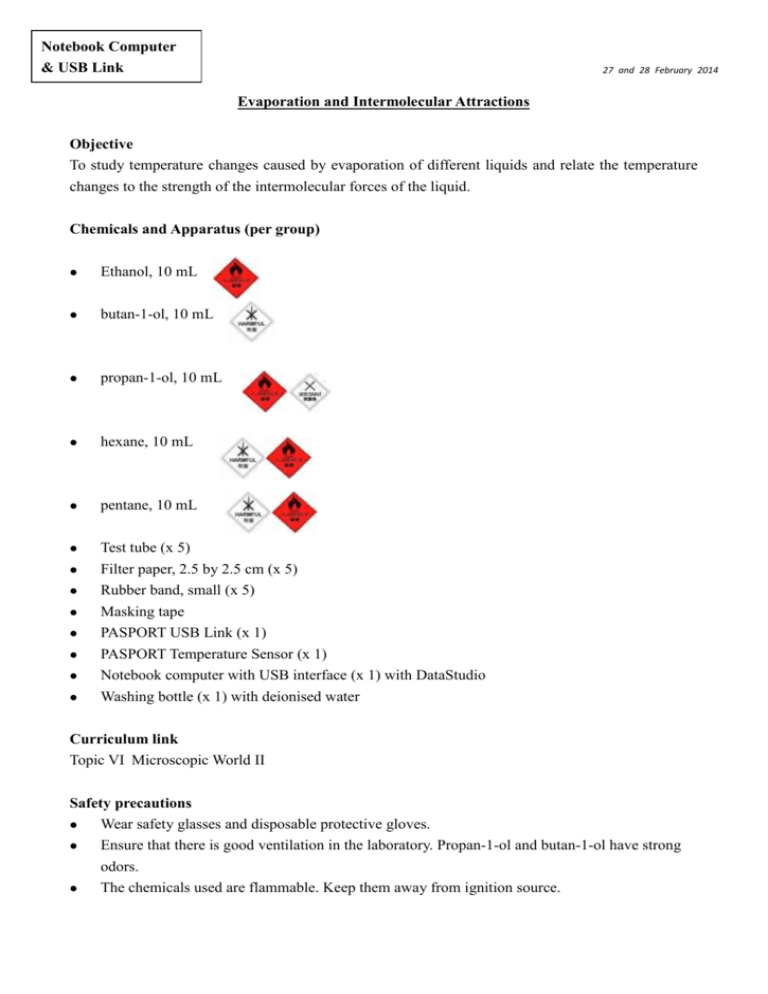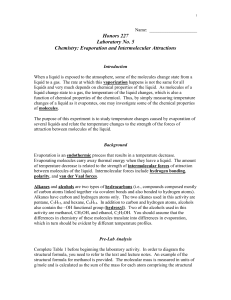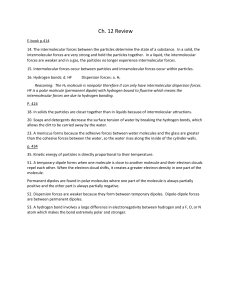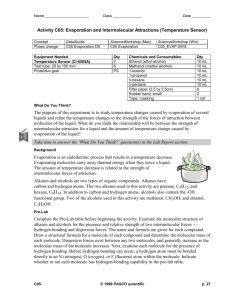Manual
advertisement

Notebook Computer & USB Link 27 and 28 February 2014 Evaporation and Intermolecular Attractions Objective To study temperature changes caused by evaporation of different liquids and relate the temperature changes to the strength of the intermolecular forces of the liquid. Chemicals and Apparatus (per group) Ethanol, 10 mL butan-1-ol, 10 mL propan-1-ol, 10 mL hexane, 10 mL pentane, 10 mL Test tube (x 5) Filter paper, 2.5 by 2.5 cm (x 5) Rubber band, small (x 5) Masking tape PASPORT USB Link (x 1) PASPORT Temperature Sensor (x 1) Notebook computer with USB interface (x 1) with DataStudio Washing bottle (x 1) with deionised water Curriculum link Topic VI Microscopic World II Safety precautions Wear safety glasses and disposable protective gloves. Ensure that there is good ventilation in the laboratory. Propan-1-ol and butan-1-ol have strong odors. The chemicals used are flammable. Keep them away from ignition source. 27 and 28 February 2014 Do not dispose of chemicals by pouring down the drain. Wash hands if any solutions are spilled onto the skin, and after all the experiments. Background Evaporation is an endothermic process that results in a temperature decrease. Evaporating molecules carry away thermal energy when they leave a liquid. The amount of temperature decrease is related to the strength of intermolecular forces of attraction. In this experiment, you will study temperature changes caused by the evaporation of several liquids and relate the temperature changes to the strength of intermolecular forces of attraction. Two types of organic compounds are involved in this experiment – alkanes and alcohols. You will examine the molecular structures of alkanes and alcohols for the presence and relative strength of two intermolecular forces – hydrogen bonding and van der Waals’ forces. Procedure Computer Setup 1. Plug the USB Link Interface into the computer’s USB port. 2. Plug the Temperature Sensor into the USB interface. 3. Start the software DataStudio, and select “Create experiment” from the Welcome window (or from File menu and select “New Activity”). 4. Drag Digits from Displays window to the main window (temperature sensor). Measurements 1. Wrap the end of the temperature sensor with a square piece of filter paper secured by small rubber band as shown in the diagram. Roll the filter paper around the sensor tip in the shape of a cylinder. The lower edge of the paper should be even with the sensor end. 2. Place the sensor in the test tube containing ethanol for 30 seconds. Make sure the container does not tip over. 27 and 28 February 2014 3. Cut 1 piece of masking tape, about 10 cm long, to be used to tape the sensor in position during data recording. 4. Record data by clicking “Start” in DataStudio. 5. After taking data for 20 seconds, remove the sensor from the liquid and place it at the edge of the table as shown in the diagram. Use the masking tape to fix the position of the sensor. 6. Stop data recording at 4 minutes. Record the minimum and maximum temperature for the liquid. Subtract the minimum temperature from the maximum temperature to determine T, the temperature change during evaporation. 7. Repeat steps 1-5 for other liquids. Data Substance Maximum Temperature, T2 (oC) Minimum Temperature, T1 (oC) T (T2-T1) (oC) Ethanol Propan-1-ol Butan-1-ol Pentane Hexane Analysis and Discussion 1. Complete the following table. Substance Formula Structural Formulae Ethanol C2H5OH Propan-1-ol C3H7OH Butan-1-ol C4H9OH Pentane C5H12 Hexane C6H14 Molecular Hydrogen Weight Bond (Yes or No) 27 and 28 February 2014 2. Explain the difference in T values of the following substances, based on their intermolecular forces. (i) Pentane and hexane (ii) Pentane and butan-1-ol 3. Based on the results of this experiment, suggest which of the alcohols studied has the strongest intermolecular forces of attraction and which has the weakest intermolecular forces. Explain how the molecular masses of the alcohols studied correspond to the T values.











